Visual Arts
Matshinanu - Nomades
GRANDE BIBLIOTHÈQUE
May 25, 2010 to September 25, 2011 - 475 de Maisonneuve Blvd. East, Arts and literature Section, level 1, and in the windows of the service counters, levels 1 to 4 - Free admission
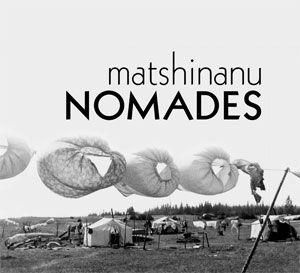
Cordes à linge de la réserve de La Romaine, entre 1949 et 1960 | Photo : Pauline Laurin
Collections de Bibliothèque et Archives nationales du Québec
Centre d’archives de la Côte-Nord, Fonds Pauline Laurin
P60, S1, SS1, P121
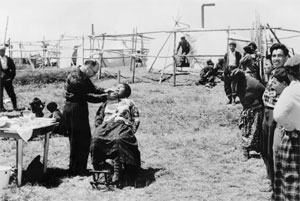
Clinique dentaire au campement indien de Natashquan, entre 1949 et 1960 | Photo : Pauline Laurin
Collections de Bibliothèque et Archives nationales du Québec
Centre d’archives de la Côte-Nord, Fonds Pauline Laurin
P60, S1, SS3, P30
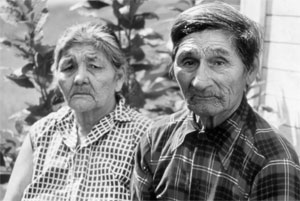
Christine et Barthelemie Connolly, 1979 | Photographe non identifié
Collections de Bibliothèque et Archives nationales du Québec
Centre d’archives de la Côte-Nord, Fonds Pauline Laurin
P60, S1, SS3, P30
DREAMING THE EARTH
"Have you met any Indians, by chance?
– Yes, but certainly not by chance."
The voyage and the territory are one, woven with bloodlines and the threads of dreams.
We thus require a guide, a voice with an authentic accent, a carrier of the language of the earth.
Tuned to the breath of the stars and the powers of the grand rivers, Joséphine Bacon, an Innu poet, writes in the eternal language of the birth of the world.
Her words have the fragile grace of a canoe's sinuous framework – a light wing that skims the water above the rocks of nostalgia.
She dreams that which she sees and she sees that which the earth dreams.
Her poetry touches the vibrant heart of the territory.
She enables us to hear the songs of those who refuse banishment, the liquid whistling of the salmon who escapes the net,
the simple things that have forever cadenced the daily life of the Innu.
The journey hence takes place between the past of the photographs and the present of the poem.
Joséphine Bacon is of the walking poets whose footfalls are recognized by the earth, as she states so well. Her voyage is timeless.
She advances, borne by the wind, humble and discreet. The mystery of an entity is a lamp that illuminates the path.
Stepping into the poetry of Joséphine Bacon, we in turn become the nomads.
Michel X Côté
Ton corps souffre sur mon corps
je te retiens
tu t’en vas
il y a des corps pires pour se perdre
mes rêves de cauchemars
sont des trous noirs
au plus profond
de mon être.
Tshitakushin tshiau
Apu ui nakatitan
tshinakashin
Nikushtatshikushin
Kashti-tipishkau anite etaian
nimateniten
niat
Joséphine Bacon
J’ai vu des horizons
que je n’ai pas atteints
des aurores
m’attendaient ce matin
où je te cherchais
et tu n’existais pas
Maintenant, je vais
où l’on t’a vu et tu
n’échapperas plus
à mes songes
Je te retrouve
dans un rêve
qui nous rassemble.
Mitshet tshishikua
apu utitaiman
Petapan nitashuapamikuat
tshetshishepaushinit
anite ka nanatuapamitan
muku apu teuane
Anutshish nitituten anite
ka uapamakuin
nipuamunit
apu tshika tshi kashushtuin
Nitshisseniten
tshe mishkatan
ekute anite mamu
e taiaku
Joséphine Bacon
This exhibition is a presentation of the Bibliothèque et Archives nationales du Québec (BAnQ) and Land InSights on the occasion of the twentieth anniversary of the First Peoples Festival.
BAnQ and Land InSights wish to express their gratitude to the Amerindian Museum of Mashteuiatsh for its collaboration on this exhibition project.
Dreaming our Paths - Land Use
CANADIAN GUILD OF CRAFTS
JUNE 4 to JUNE 26 – 1460 Sherbrooke Street West
John Sabourin
Dreaming our Paths – Carvings
The free-flowing possibilities of the meandering lines of water and the northern lights transform into birds' heads or human figures and animal heads.
Dene artist John Sabourin explores the complex relationships between humans and nature and embraces his cultural roots by bringing stone to life in stories and legends.
"Northern wildlife is the umbilical cord that connects us to the land and I try to epitomize that in my carvings. I feel that the challenge to tell a story out of stone is a unique one, but I am able to do it using my own style of carving and by making changes in the way I do things to suit the story.''
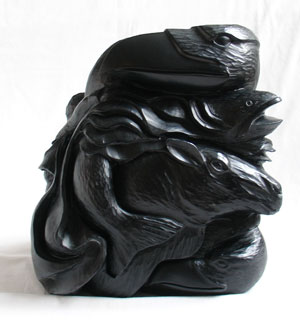
John Sabourin
A Gentle Dream
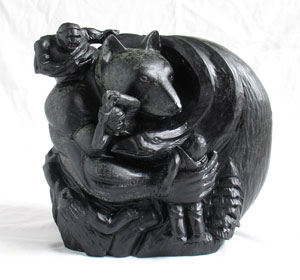
John Sabourin
Reclaiming Our Voice
Land Use – Paintings
John Sabourin had the privilege of working for three years in land use management in his home community of Llidlli kue/Fort Simpson in the Northwest Territories, where he heard elders talk about the way they ''used'' the land and listened to others discussing development possibilities on northern lands.
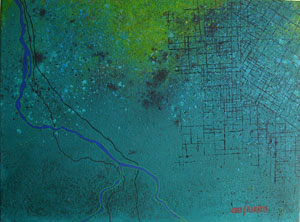
John Sabourin
Fourty Below Spirit
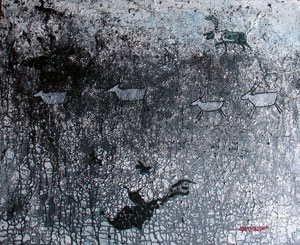
John Sabourin
Pipe Dreams
Venezuela indigena: universo sonoro
SIMON BOLIVAR CULTURAL CENTRE
June 14 to July 4
Monday to Friday, noon to 7 pm
394 de Maisonneuve Blvd. West
An Exhibition of Sounds, corporal manifestations and indigenous knowledge in Venezuela
This multimedia presentation offers a window into the connection between sonority and knowledge amongst the numerous and diverse indigenous peoples of Venezuela. In current times of interconnected societies, and thus increasing global homogenization, an appreciation of the cosmologies of the indigenous peoples of the Americas offers alternative ways of understanding and being in the world. It also allows cultural practices and ways of knowing to be preserved and disseminated for the benefit of future generations.
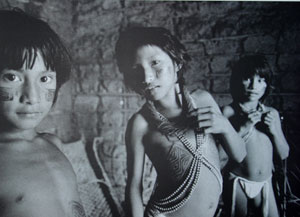
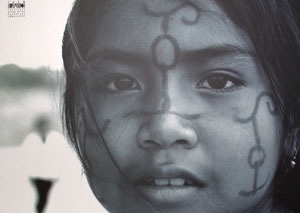
Through Ancient Eyes
KANIEN’KEHA:KA ONKWAWÉN:NA RAOTITIOHKWA LANGUAGE AND CULTURAL CENTER
June 1 to July 29 – Kahnawake, 450 638-0880
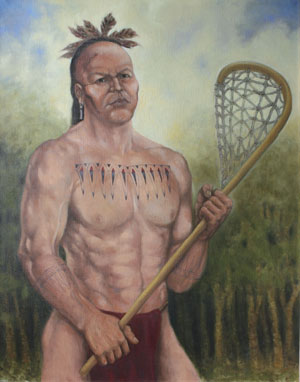
R. Kakwirakeron Montour
Tewaarathon the Master Stick
Through his paintings, R. Kakwirakeron Montour follows the path of his ancestors, searching for who they were to better understand what it is to be a Mohawk today.
Where Our Home Is
ÉCOLE ROTIWENANKÉHTE ET ARONHIATÉKHA
June 19 and 20; and from June 25 to 27, 11 am to 5 pm - 407 Saint-Michel Street, Kanesatake
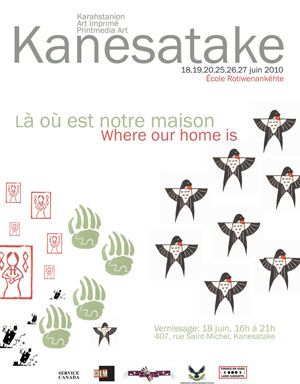
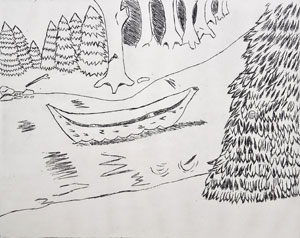
Alannah Gabriel
Great Pine River
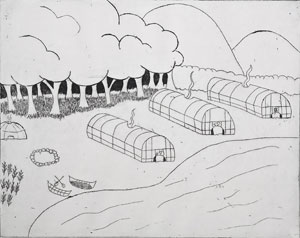
Melinda Nelson
Where Home Is
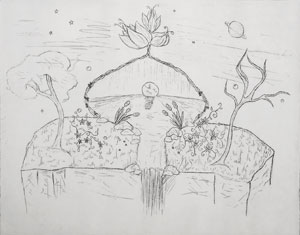
Melissa Cree
End of the World
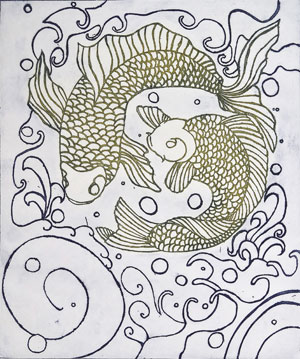
Sherry Benedict
Bubbles
For a third consecutive year, the Centre de l’Estampe et de l’Image de Mirabel (CIEM) has welcomed Kanesatake youth in a program of creative apprenticeship, and the results never cease to astonish. For the participants, art becomes a path to knowledge; beyond the production of quality works, students are summoned to live new experiences in an unfamiliar milieu, each at their own rhythm. Here art is a catalyst; it empowers these young people to revision who they are, their origins, and the territory that is theirs.
Rotiwenankéhte
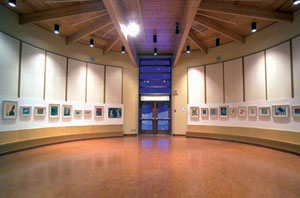
Located on beautiful ancestral grounds in the Pines, the immersion school Rotiwenankéhte was built after the 1990 Oka Crisis. The parents of Kanehsatà:ke felt the need to protect, preserve and promote the Kanien’kéha language and culture. They decided to build a Kanien’kéha immersion school that would transmit their Kanien’kéha language and traditional teachings. The outstanding cultural design of the school facility compliments its surroundings, and culminates in an attractive round room to accommodate traditional teachings and cultural activities for the children.
Today the Rotiwenankéhte school is shared with a regular bilingual school, Aronhiatékha, along with the immersion in Mohawk language and culture.
On July 10 and 11, 2010, the school will host events commemorating the 1990 Oka Crisis. One of the activities will be the launching of the French version of the Kanehsatà:ke history book At The Woods’ Edge by Arlette Kawanatatie Van Den Hende and Brenda Katlatont Gabriel-Doxtater. Francine Lemay, sister of Corporal Lemay, courageously volunteered to translate the history book into French to inform the French-speaking Québécois of the history of the Kanien’kehá:ka (Mohawk People) and of the events leading up to the Oka Crisis.
A prelaunch of the book À l'orée des bois (At The Woods’ Edge) will take place alongside the vernissage of the Where Our Home Is exhibition on June 18 at 6 pm.
The artists
ALANNAH GABRIEL – Training at CIEM enabled animation drawing artist Alannah Gabriel to strengthen awareness of her national identity. The artist's print compositions feature iconographic and historical symbols of personal importance, particularly the birds that are prevalent in her culture.
MELINDA NELSON – Melinda Nelson delved into the experiences, books, and stories of her childhood as inspiration for rediscovering her identity through art. She composes visual narratives describing Mohawk legends, and employs poster-making to convey her ideas, via both the written word and the numerous icons used by her people.
MELISSA CREE – Melissa Cree uses her own language of symbols involving utilitarian objects, animals, people, and imaginary characters, to express herself artistically through drawing and animation. She will continue to evolve the multiple methods she learned at CIEM through creating characters with their own personalities, stories and legends.
SHERRY BENEDICT – Discovering the ability to create images allowed Sherry Benedict to explore her identity using icons drawn from her Mohawk heritage, including symbols, emblems and legends. The art of poster-making with letter- press, and digital imagery in particular, allowed Sherry Benedict to combine visual composition with meaningful text about her national heritage.










